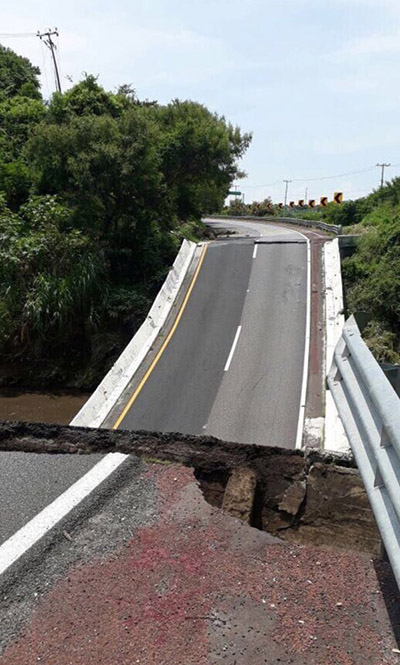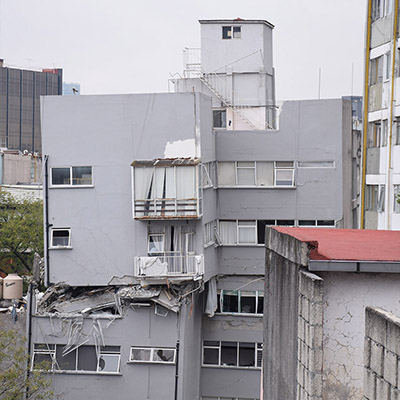Civil Engineering Professor Documents Experience Studying Mexico Earthquake
Civil engineering professor Clint Wood traveled to Mexico City and Puebla, Mexico, last week to study the recent earthquake's impact on buildings and infrastructure. He was chosen to participate in a Geotechnical Extreme Events Reconnaissance, or GEER, mission sponsored by the National Science Foundation.
As a geotechnical earthquake engineer, Wood focuses his research on dynamic soil characterization. He uses broadband seismometers to measure low-intensity stress waves. By measuring the frequency and wavelength of these waves as they pass through arrays of seismometers, he can estimate the shear-wave velocity and layering of the soil underneath the arrays. Understanding the shear-wave velocity of the soil helps engineers understand ground motions recorded during earthquakes and contributes to the design of buildings that can better withstand various stress waves created by earthquakes.
Below is Wood's account of his experience:
Early in our trip, we spent two days in a neighborhood of Mexico City called La Condesa, where several areas had a number of buildings either collapse or sustain heavy damage, while other areas of Mexico City were relatively unaffected. Teams assessed damage to each building, documented building type and recorded settlement and/or crack measurements.
 Masonry damage to a church in Santa Rosa Treinta. Masonry damage to a church in Santa Rosa Treinta. |
 Bridge failures severed lifelines to rural areas. Bridge failures severed lifelines to rural areas. |
 Wood observed buildings that had one floor collapse while all other levels remained intact. |
I made shear-wave-velocity and site-frequency measurements in both damaged and undamaged areas to understand the role the soil under the areas played in the observed damage pattern. My group will use the results to determine whether specific soil conditions under the buildings or areas caused larger amplifications compared to other areas.
Like a guitar string, soil columns and buildings have fundamental or "natural" frequencies of vibration. The natural frequency of a soil column or building is dependent on the stiffness (shear wave velocity) and depth, or height, of the building or soil column. When earthquakes occur, stress waves over a broad range of frequencies are produced. As those stress waves propagate from bedrock up through the soil column, frequencies near the natural frequency of the soil column tend to be amplified. If the natural frequency of a soil column and building match, much higher seismic demand is often placed on the building. This condition, called double-resonate, in the building and soil can result in significantly higher damage to buildings that are not designed for this higher level of ground shaking.
During our final days in Mexico, we traveled to Puebla and some smaller towns farther south, closer to the epicenter. A number of good case histories were observed in these towns, including three 22-story buildings that had structural distress and rocking of the foundations. We made measurements at these structures, so we could estimate the seismic demand on the structures to better evaluate their performance.
Typical failures of unreinforced masonry structures were observed throughout the smaller towns. We also observed several bridge embankment failures that severed lifelines to some smaller areas.
Overall, many deaths from the earthquake were caused by the collapse of structurally deficient buildings, most of which were built before 1985, when a large subduction zone earthquake killed more than 5,000 people in the Mexico City area. Many of these buildings had what structural engineers call "soft story" parking areas, meaning they contained fewer interior walls in the first story to allow for parking. Soft stories are a problem during earthquakes because they have lower shear resistance than upper floors making the first story more vulnerable to collapse. This emphasizes the need for seismic retrofit of buildings considered structurally deficient.
When ground shaking occurs due to an earthquake, buildings want to stay in place due to inertia forces, while the ground moves under the building. This creates tremendous lateral or shear forces on the building. Buildings that have adequate vertical supports to resist gravity loads may lack the necessary shear resistance to address the lateral forces caused by an earthquake. Buildings lacking shear reinforcement or lateral capacity often fail during earthquakes. Some collapse entirely, but in other buildings, the bottom floor — or even a middle floor! — collapse while the rest of the building remains intact.
This may sound odd, but, destructive as this earthquake was, it could have been worse. Rather than a subduction zone earthquake, similar to the 1985 earthquake where the fault rupture is near the intersection of two tectonic plates, the recent magnitude 7.1 earthquake was what geologists call an intra-plate earthquake, meaning the pressure at the edges of the tectonic plates caused stress and movement within the plate. Subduction zone earthquakes often produce more low-frequency waves that cause greater damage to taller buildings and would have placed a higher seismic demand on many tall structures in Mexico City.
To learn more about Wood's research, visit Wood's geotechnical lab's website.
A short video about Wood's research can be viewed on the Research Frontiers website.
Topics
Contacts
Clint Wood, assistant professor
Civil Engineering
479-575-6084,
cmwood@uark.edu
Matt McGowan, science and research communications officer
University Relations
479-575-4246,
dmcgowa@uark.edu
Headlines
Four Students Named Goldwater Scholars; Two Earn Udall Honorable Mentions
Four U of A students have received the prestigious Goldwater Scholarship, an award for top students in mathematics, science, and engineering.
Cross-Campus Collaboration Culminates in New Outdoor Geological Installation
Grand opening event to celebrate the new GeoLab installation at the U of A’s Gearhart Hall courtyard is set for May 3. The installation will be open to the public year-round.
First Students to Use Online Degree to Hone Nursing Leadership, Elevate Patient Care
Hanna Baxendale and Wendi Kimbrell will begin coursework in the Doctor of Nursing Practice-Executive Master of Business Administration program offered by the Eleanor Mann School of Nursing and Walton College.
Join the Office for Sustainability on a Final Cruise to Campus
Cruise to Campus Wednesdays have fostered a gathering space for individuals interested in biking to campus. Drop by the Old Main Lawn from 7:30-10 a.m. Wednesday for coffee, something to eat and conversation.
Fay Jones School Student Ambassador Program Gives Voice to Design Students
The student ambassador program at the Fay Jones School of Architecture and Design is built to connect top design students with their school, its alumni, its future students and others inside and outside the school.





